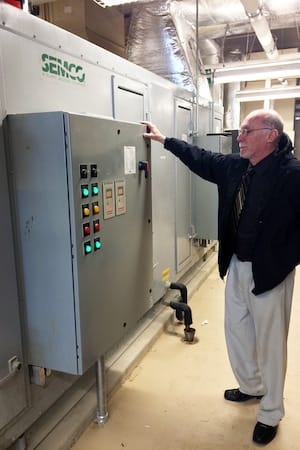 The new $60-million George Rogers Clark High School’s (GRCHS) green design is helping record up to 35% less monthly utility costs while providing better indoor air quality and comfort than the 30-percent smaller conventional building it replaced.
The new $60-million George Rogers Clark High School’s (GRCHS) green design is helping record up to 35% less monthly utility costs while providing better indoor air quality and comfort than the 30-percent smaller conventional building it replaced.
One reason for the increased efficiency is a hybrid HVAC design featuring a geothermal well field that supplies active chilled beams, dual wheel outdoor air dehumidification systems and other cutting-edge technologies, according to Paul Christy, superintendent, Clark County Public Schools. Christy, the county schools’ former director of operations, oversaw the 300,000-square-foot high school’s HVAC design team that included engineer, Charles H. Wade, P.E., LEED AP, vice president, KTA Engineers, Lexington, Ky; Mark Saunier, B.S.E.E., LEED AP, CEM and president of energy company, Comfort & Process Solutions, Lexington; and engineers from SEMCO, a Columbia, Mo.-based manufacturer of chilled beams and heat recovery outdoor air equipment. D.W. Wilburn Construction Co., Somerset, Ky, oversaw the construction and HVAC installation.
Originally specified as a conventional 200-foot, 80-well geothermal field with just GSHPs, Christy opted for enhancing the design by replacing the proposed 350 heat pumps with 542 active chilled beams and six SEMCO Pinnacle Series dedicated outdoor air (DOAS) heat recovery systems. Christy’s decision was based on visiting a similar system at Greenville, S.C.-based Furman University and reviewing an 18-page building energy simulation report prepared by SEMCO.
The IQHC chilled beams, which are supplied by a water-to-water GSHP by Climate Master, Oklahoma City, Okla., have a 12-slot nozzle that’s field-adjustable for areas with excessive solar gain or heat loss. CPS service department is training the GRCHS maintenance staff to adjust volume and up to a 45-degree angle directional airflow for hotspots with each chilled beams’ easily-accessed hand-operated levers for the greatest air flow flexibility efficiency. The nozzle adjustment additionally provides a unilateral, disproportional or equal air volume from each side. It allows ideal room coverage and flexible distribution possibilities without relocating the device.
The chilled beams never develop condensation because five rooftop DOAS units ranging from 3,700 to 14,500-cfm supply them with semi-neutral, super dry air. There is one 7,000-cfm DOAS that resides in a mechanical room. Some areas with high ceilings that aren’t ideal for chilled beams, such as the cafeteria and gym, use their own DOAS to distribute cooling and heating via the GSHP loop.

Paul Columbia (l), Administrative Director of Operations, Clark County Public Schools discusses the ClimateMaster unit with Paul Christy.
Besides energy savings, GRCHS also received the following benefits from the HVAC system:
- saved 2,000-square-feet of storage space that would have been consumed by heat pumps in two mechanical rooms that are now used for storage and other uses;
- reduced maintenance because chilled beams require no filters and moving parts, thus eliminating any periodic classroom interrupting maintenance tasks;
- less piping because only two of every classroom’s four chilled beams were four-piped. Additionally, chilled beam piping diameters are considerably smaller than the original configuration of piping heat pumps to each classroom;
- reduced ductwork because chilled beams require only six-inch-supply take-offs and half the air volume of a traditional system;
- quieter classroom environments because chilled beams are approximately 10 to 15-db quieter than heat pumps;
- better temperature and humidity control by independently controlling each load.
A building energy simulation report, which was completed by using the Carrier hourly analysis program (HAP) in conjunction with SEMCO’s supplemental Pinnacle hourly energy analysis module, compared the estimated annual energy consumption of the high school’s three most-likely HVAC approaches:
1) a DX-based outdoor air system, including a total energy recovery wheel and hot gas reheat capabilities preconditioning the outdoor air delivered directly to the classroom spaces served by individual GSHPs.
2) a dedicated outdoor air system (DOAS) incorporating both energy recovery and passive dehumidification wheels, served by a ground source heat pump to precondition outdoor air delivered directly to the classroom spaces served by individual GSHPs.
3) a DOAS and active chilled beams combination, all served by a GSHP chiller to condition the media center and all classrooms.





Join the conversation: